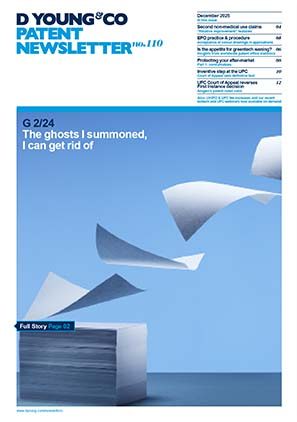4th amendment to the Chinese Implementing Regulations of the Patent Law: implications for foreign applicants
The Chinese State Council issued the 4th amendment of the Chinese Implementing Amended Regulations of the Patent Law (Amended Regulations) on 21 December 2023.
On the same evening, the Chinese National Intellectual Property Administration (CNIPA), which is an institution under the State Council, released an updated version of the Guidelines for Patent Examination.
Both the Amended Regulations and Guidelines took effect on 20 January 2024, aligning them with the new Chinese Patent Law, which was passed by the Chinese National People’s Congress Standing Committee on 23 October 2020 and came into effect on 01 June 2021.
Compared to the previous version of the Chinese Regulations, issued in 2010, the current revision brings forth significant changes to catch up with the growth and development of the Chinese patent system (covering invention patents, utility models, and design patents) over the past thirteen years.
According to the CNIPA, the Amended Regulations’ target is to contribute to the creation of a world-class business environment through the provision of a more user-friendly patent application process, improved quality of patent examination, strengthened administrative protection for patents, promotion of the exploitation of patent rights, and enhanced alignment with relevant international practice.
The amendment of the Regulations primarily pertains to the institutional implementation of the reformed framework outlined by the new Chinese Patent Law. In this article we highlight some of the new provisions which may have important implications for foreign patent applicants.
Patent term adjustment (PTA)
The Amended Regulations specify the conditions, time limits, and calculation methods for patent term adjustment, which is available to patents that have experienced examination delays. In particular, this provision comes into play for patents granted four years after the filing date and three years after filing a request for examination.
Patent term extension (PTE)
The Amended Regulations also clarify the arrangements for patent term extension, which apply to product patents, preparation method patents, and medical use patents for the active pharmaceutical ingredient (API) in a new drug.
The extension duration is determined by the gap between the China marketing approval date and the Chinese patent filing date, with a maximum cap of five years. Meanwhile, the cumulative effective patent term following drug approval cannot exceed fourteen years.
Patent Open License system
The Amended Regulations confirm the procedures and requirements for open licence declaration that were previously announced in the CNIPA Trial Program on Patent Open License. Notably, the Chinese open license system differs from its UK counterpart by requiring the disclosure of core licensing terms, including royalty calculation.
Principle of good faith
In order to regulate abnormal patenting activities, the Amended Regulations stipulate that the compliance of the principle of good faith by the applicant during patent prosecution will be accessed by CNIPA during examination, re-examination, and invalidation proceedings. For instance, patent applications must be based on genuine inventive activities.
Non-compliance with the principle of good faith may lead to patent rejection or invalidation, in addition to an administrative penalty capped at RMB 100,000 (approximately GBP 11,000).
Partial design protection
The examination requirements for design patent applications involving a part of a wider product, commonly known as “partial design”, are now confirmed by the Amended Regulations. For example, partial design is deemed non-patentable unless it forms a relatively independent portion of the product or constitutes a relatively complete design unit.
CNIPA to deal with patent infringement disputes
The CNIPA may have jurisdiction over patent infringement disputes with significant nationwide impact. In such cases, the CNIPA can adjudicate on both infringement and patent validity. This may reduce any uncertainty and inconsistency resulting from the bifurcation of traditional Chinese patent litigation, in which actions for patent infringement and counterclaims for patent invalidity are separately handled by the Chinese Courts and the CNIPA.
Apart from the above, the Amended Regulations also introduce new measures that were not addressed in the new Chinese Patent Law, with notable changes including the following:
Restoration, addition, and correction of priority rights
The Amended Regulations provide for remedial procedures for the inadvertent loss of priority rights within the twelve month limit. This aligns with international practice, and in particular provisions under Article 13(2) of the Patent Law Treaty.
The Amended Regulations also allow the applicant to incorporate the content of an earlier application through reference, when filing a Chinese patent application.
Non-prejudicial disclosure
Under the Amended Regulations, the scope of non-prejudicial disclosure now additionally encompasses disclosure made in academic or technical conferences organised by international organisations, including standard-setting organisations, and recognised by the State Council authorities.
Awards and remuneration for employees’ inventions
The Amended Regulations revise the monetary values associated with awards and remuneration for employees’ inventions.
In addition, the Amended Regulations stipulate that, in the absence of a relevant agreement between the employer and the inventor/designer, remuneration calculation shall follow the inventor-favoured method outlined in the “Law of Promoting the Transformation of Scientific and Technological Achievements”.
15-day rule abolished
Similar to the corresponding 10-day rule mailing grace period at the European Patent Office (EPO), the CNIPA will also phase out the 15-day rule practice for official communications issued electronically, aiming to streamline the patent examination timeframe.
Deferral of examination
The Amended Regulations provide patent applicants the option to request a deferral of substantive examination. Applicants for Chinese patent applications may now adopt more flexible filing strategies for global patent filing, such as by taking advantage of the Patent Prosecution Highway (PPH) programmes between CNIPA and patent offices worldwide.
Foreign applicants dealing with the CNIPA
Foreign applicants and patentees are now permitted to directly engage with the CNIPA regarding certain prescribed procedures, such as the filing of certified priority documents and annuity payment. This will allow cost optimisation for maintaining their patent portfolios in China.
Scope of re-examination
The Amended Regulations provide that, during re-examination proceedings, the Patent Re-examination and Invalidation Department of CNIPA may, ex officio, address “apparent” deficiencies contained in a patent application, beyond those initially identified in the rejection decision.
Compared with the traditional practice of referring the application back to the examining division for further examination, the new measure is expected to reduce the burden of the applicants in the patent application process, by avoiding multiple rounds of re-examination proceedings.
Examination of utility model and design patent applications
As a further measure to combat against abnormal patent applications, the Amended Regulations empower the examining division to reject a utility model application if it “apparently” lacks an inventive step compared to the prior art. Similarly, a design patent application may be rejected if it “apparently” does not exhibit significant differences from prior design or a combination of prior design features.
Hague system for the international registration of industrial designs
Following China’s recent accession to the Hague System for the international registration of industrial design, the Amended Regulations now include a dedicated new chapter which sets out the filing procedures and examination criteria for international design applications submitted to the CNIPA.
In short
In summary, the Amended Regulations further refine and optimise the existing Chinese patent system, which granted 645,036 invention patents, 2,701,164 utility models, and 716,603 design patents from January to November of 2023.
In addition, the Amended Regulations are also seen as a commitment to implementing the national strategy of strengthening the country through intellectual property, and offering strong support for innovation-driven development.
Useful link
Announcement of the amendment to the Implementing Amended Regulations of the Patent Law: dycip.com/china-patent-law-dec2023

